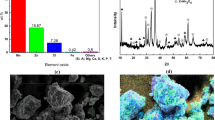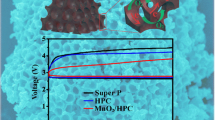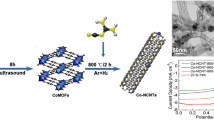Abstract
Metal–oxygen batteries have been growing rapidly as an energy storage technology in light of their high specific energy density. However, waste metal–oxygen batteries will raise many environmental issues; therefore, the recycling and reusing of the spent metal–oxygen batteries has attracted great attention. Herein, we report the 2-phenyl-4,4,5,5-tetramethylimidazoline-1-oxyl-3-oxide (PTIO) as a redox mediator for manganese–oxygen battery (MOB). Trace amounts of PTIO result in the discharge capacity of MOB increase to 2588 mAh g−1 and enhance the formation of manganese dioxide (MnO2) with toroidal appearance and high crystallinity on the cathode. After being used, the dismantled MnO2/carbon nanotube (CNT) cathode can be reused as an electrode for supercapacitor via simple calcining at mild temperature. The recycled free-standing MnO2/CNT electrode demonstrates an exceptional specific capacitance (253.86 F g−1) at a current density of 0.5 A g−1 in a 0.5 M Na2SO4 electrolyte. Moreover, we prepare an asymmetric supercapacitor fabricated with the recycled MnO2/CNT electrode and activated carbon (AC), which exhibits excellent energy density (32.00 Wh kg−1 at 413.70 W kg−1) with 78.26% retention over 6000 cycles. This work provides a promising strategy to derive high-quality and high-value MnO2/CNT electrode materials from the spent MOBs.
Graphical abstract
It’s the 2-phenyl-4,4,5,5-tetramethylimidazoline-1-oxyl-3-oxide (PTIO) as a redox mediator for manganese-oxygen battery (MOB). The recycled manganese dioxide (MnO2)/carbon nanotube (CNT) cathode can be reused as an electrode for supercapacitor via simple calcining at mild temperature. The recycled MnO2/CNT electrode shows the toroidal appearance and high crystallinity. Furthermore, the asymmetric supercapacitor fabricated with the MnO2/CNT free-standing electrode displays high specific capacitance, superior energy density, and good cyclic ability.





Similar content being viewed by others
References
Li L, Chang Z, Zhang X (2017) Recent progress on the development of metal-air batteries. Adv Sust Syst 1:1700036
Cheng F, Chen J (2012) Metal-air batteries: from oxygen reduction electrochemistry to cathode catalysts. ChemInform 41:2172–2192
Wang H, Xu Q (2019) Materials design for rechargeable metal-air batteries. Matter 1:565–595
Gu P, Xu Y, Zhao Y, Liu W, Xue H, Pang H (2017) Electrocatalysis of rechargeable non-lithium metal-air batteries. Adv Mater Interfaces 4:1700589
Li Y, Lu J (2017) Metal-air batteries: will they be future electrochemical energy storage of choice? ACS Energy Lett 2:1370–1377
**n Z, Wang XG, **e Z, Zhen Z (2016) Recent progress in rechargeable alkali metal-air batteries. Green Energy Environ 1:4–17
Lan J, Sun Y, Tian H et al (2021) Electrolytic manganese residue-based cement for manganese ore pit backfilling: performance and mechanism. J Hazard Mater 411:124941
Shu J, Liu R, Liu Z, Chen H, Tao C (2016) Enhanced extraction of manganese from electrolytic manganese residue by electrochemical. J Electroanal Chem 780:32–37
Chen H, Long Q, Zhou F, Shen M (2020) Elec-accumulating behaviors of manganese in the electrokinetics-processed electrolytic manganese residue with carbon dioxide and oxalic acid. J Electroanal Chem 865:114162
Smith EL, Abbott AP, Ryder KS (2014) Deep Eutectic Solvents (DESs) and Their Applications. Chem Re 114:11060–11082
Atilhan M, Aparicio S (2021) Review and perspectives for effective solutions to grand challenges of energy and fuels technologies via novel deep eutectic solvents. Energ Fuel 35:6402–6419
Bozzini B, Kazemian M, Kiskinova M, Kourousias G, Mele C, Gianoncelli A (2019) Operando soft X-ray microscope study of rechargeable Zn-air battery anodes in deep eutectic solvent electrolyte. X-Ray Spectrom 48:527–535
Bogolowski N, Drillet J (2018) Activity of different AlCl3-based electrolytes for the electrically rechargeable aluminium-air battery. Electrochim Acta 274:353–358
Johnson L, Li C, Liu Z et al (2014) The role of LiO2 solubility in O2 reduction in aprotic solvents and its consequences for Li-O2 batteries. Nat Chem 6:1091–1099
Aetukuri NB, Mccloskey BD, García JM, Krupp LE, Luntz AC (2015) Solvating additives drive solution-mediated electrochemistry and enhance toroid growth in non-aqueous Li-O2 batteries. Nat Chem 7:50–56
Guo L, Wang J, Ma S, Zhang Y, Wang E, Peng Z (2017) The origin of potential rise during charging of Li-O2 batteries. Sci China Chem 60:1527–1532
Tamirat AG, Guan X, Liu JY, Luo JY, **a YY (2020) Redox mediators as charge agents for changing electrochemical reactions. Chem Soc Rev 49:7454–7478
Qi JL, Yan YT, Cai YF, Cao J, Feng JC (2021) Nanoarchitectured design of vertical-standing arrays for supercapacitors: progress, challenges, and perspectives. Adv Funct Mater 31:2006030
Yan YT, Lin JH, Cao J, Guo S, Zheng XH, Feng JC, Qi JL (2019) Activating and optimizing the activity of NiCoP nanosheets for electrocatalytic alkaline water splitting through the V do** effect enhanced by P vacancies. J Mater Chem A 7:24486
Yan YT, Liu JQ, Huang KK, Qi JL, Qiao L, Zheng XH, Cai W (2021) A fast micro-nano liquid layer induced construction of scaled-up oxyhydroxide based electrocatalysts for alkaline water splitting. J Mater Chem A 9:26777
Zhao Y, Yuan X, Jiang L, Wen J, Wang H, Guan R, Zhang J, Zeng G (2020) Regeneration and reutilization of cathode materials from spent lithium-ion batteries. Chem Eng J 383:123089
Du KD, Ang EH, Wu XL, Liu Y (2021) Progresses in sustainable recycling technology of spent lithium-ion batteries. Energy Environ Mater. https://doi.org/10.1002/eem2.12271
Wang Y, An N, Wen L, Wang L, Jiang X, Hou F, Yin Y, Liang J (2021) Recent progress on the recycling technology of Li-ion batteries. J Energy Chem 55:391–419
Yao Y, Zhu M, Zhao Z, Tong B, Fan Y, Hua Z (2018) Hydrometallurgical processes for recycling spent lithium-ion batteries: a critical review. ACS Sustainable Chem Eng 6:13611–13627
Harper G, Sommerville R, Kendrick E, Driscoll L, Anderson P (2019) Recycling lithium-ion batteries from electric vehicles. Nature 575:75–86
Swain B (2017) Recovery and recycling of lithium: a review. Sep Purif Technol 172:388–403
Lv W, Wang Z, Cao H, Sun Y, Zhang Y, Sun Z (2018) A critical review and analysis on the recycling of spent lithium-ion batteries. ACS Sustainable Chem Eng 6:1504–1521
Yang T, Lu Y, Li L et al (2020) An effective relithiation process for recycling lithium-ion battery cathode materials. Adv Sust Syst 4:1900088
Li X, Zhang J, Song D, Song J, Zhang L (2017) Direct regeneration of recycled cathode material mixture from scrapped LiFePO4 batteries. J Power Sources 345:78–84
Yang S, Chen G, Chen Z (2018) Effective regeneration of LiCoO2 from spent lithium-ion batteries: a direct approach towards high-performance active particles. Green Chem 20:851–862
Mao Y, Shen X, Wu Z, Zhu L, Liao G (2020) Preparation of Co3O4 hollow microspheres by recycling spent lithium-ion batteries and their application in electrochemical supercapacitors. J Alloys Compd 816:152604
Wang L, Gu Y, Wei J, Wu X (2020) Li-Ni-Co-Mn oxides powders recycled from spent lithium-ion batteries for OER electrodes in CO2 reduction. Environ Technol Innov 18:100732
Peng WY (2013) Preparation and electrochemical performance of nano-Co3O4 anode materials from spent li-ion batteries for lithium-ion batteries. J Mater Sci Technol 29:215–220
** G, Heng X, Dun C, Zhang Y (2020) The influence of MgO on the magnetic and magnetostrictive properties of CoFe2O4 nanoparticles synthesized using spent LIBs. Phys B 589:412182
Zhang L, Wu S, Wan Y, Huo Y, Luo Y, Yang M, Li M, Lu Z (2017) Mn3O4/carbon nanotube nanocomposites recycled from waste alkaline Zn-MnO2 batteries as high-performance energy materials. Rare Met 36:442–448
Natarajan S, Kaipannan S, Lee YS, Sathish M, Aravindan V (2020) Sandwich layered Li0.32Al0.68MnO2(OH)2 from spent Li-ion battery to build high-performance supercapacitor: Waste to energy storage approach. J Alloys Compd 827:154336
Xu CY, Xu GY, Zhang YD, Fang S, Nie P, Wu L, Zhang XG (2017) Bifunctional redox mediator supported by an anionic surfactant for Long-Cycle Li-O2 batteries. ACS Energy Lett 2:2659–2666
Chou S, Wang J, Chew S, Liu H, Dou S (2008) Electrodeposition of MnO2 nanowires on carbon nanotube paper as free-standing, flexible electrode for supercapacitors. Electrochem Commun 10:1724–1727
Li L, Hu ZA, An N, Yang YY, Li ZM, Wu HY (2014) Facile synthesis of MnO2/CNTs composite for supercapacitor electrodes with long cycle stability. J Phys Chem C 118:22865–22872
Li Z, Wang J, Liu S, Liu X, Yang S (2011) Synthesis of hydrothermally reduced graphene/MnO2 composites and their electrochemical properties as supercapacitors. J Power Sources 196:8160–8165
He G, Duan Y, Song L, Zhang X (2019) Do** strategy to boost electromagnetic property and gigahertz tunable electromagnetic attenuation of hetero-structured manganese dioxide. Dalton T 48:2407–2421
Rana M, Avvaru VS, Boaretto N, O’Shea V, Marcilla R, Etacheri V, Vilatela JJ (2019) High rate hybrid MnO2@CNT fabric anodes for Li-ion batteries: properties and a lithium storage mechanism study by in situ synchrotron X-ray scattering. J Mater Chem A 7:26596–26606
Qin B, Jia HN, Cai YF, Li MN, Qi JL, Cao J, Feng JC (2020) Antimony nanocrystals self-encapsulated within bio-oil derived carbon for ultra-stable sodium storage. J Colloid Interface Sci 582:459–466
Qin B, Cai YF, Wang PC, Zou YC, Cao J, Qi JL (2022) Crystalline molybdenum carbide-amorphous molybdenum oxide heterostructures: In situ surface reconfiguration and electronic states modulation for Li−S batteries. Energy Stor Mater 47:345–353
Gao W, Wan Y, Dou Y, Zhao D (2011) Synthesis of partially graphitic ordered mesoporous carbons with high surface areas. Adv Energy Mater 1:115–123
Liu M, Gan L, **ong W, Xu Z, Zhu D, Chen L (2014) Development of MnO2/porous carbon microspheres with a partially graphitic structure for high performance supercapacitor electrodes. J Mater Chem A 2:2555–2562
Cakici M, Kakarla RR, Alonso-Marroquin F (2017) Advanced electrochemical energy storage supercapacitors based on the flexible carbon fiber fabric-coated with uniform coral-like MnO2 structured electrodes. Chem Eng J 309:151–158
Peng R, Wu N, Zheng Y, Huang Y, Luo Y, Yu P, Zhuang L (2016) Large-scale synthesis of metal-ion-doped manganese dioxide for enhanced electrochemical performance. ACS Appl Mater Inter 8:8474–8480
Jeong JH, Park JW, Lee DW, Baughman RH, Kim SJ (2019) Electrodeposition of alpha-MnO2/gamma-MnO2 on carbon nanotube for yarn supercapacitor. Sci Rep 9:11271
Wang JG, Kang F, Wei B (2015) Engineering of MnO2-based nanocomposites for high-performance supercapacitors. Prog Mater Sci 74:51–124
Yang Y, Niu H, Qin F, Guo Z, Shen W (2020) MnO2 doped carbon nanosheets prepared from coal tar pitch for advanced asymmetric supercapacitor. Electrochim Acta 354:136667
He Z, Mansfeld F (2008) Exploring the use of electrochemical impedance spectroscopy (EIS) in microbial fuel cell studies. Energ Environ Sci 22:215–219
Wu SS, Chen WF, Yan LF (2014) Fabrication of a 3D MnO2/graphene hydrogel for high-performance asymmetric supercapacitors. J Mater Chem A 2:2765
Cottineau T, Toupin M, Delahaye T, Brousse T, Belanger D (2006) Nanostructured transition metal oxides for aqueous hybrid electrochemical supercapacitors. Appl Phys A 82:599–606
Li YJ, Yu N, Yan P et al (2015) Fabrication of manganese dioxide nanoplates anchoring on biomass-derived cross-linked carbon nanosheets for high-performance asymmetric supercapacitors. J Power Sources 300:309–317
Xu HH, Hu XL, Yang HL, Sun YM, Hu CC, Huang YH (2014) Flexible asymmetric micro-supercapacitors based on Bi2O3 and MnO2 nanoflowers: larger areal mass promises higher energy density. Adv Energy Mater 5:1401882
Cao JY, Wang YM, Zhou Y, Ouyang JH, Jia DC, Guo LX (2013) High voltage asymmetric supercapacitor based on MnO2 and graphene electrodes. J Electroanal Chem 689:201–206
Funding
This work was supported by the National Natural Science Foundation of China (U1802256), Leading Edge Technology of Jiangsu Province (BK20202008), Priority Academic Program Development of Jiangsu Higher Education Institutions (PAPD), and Graduate Open Fund of Nan**g University of Aeronautics and Astronautics (kfjj20200604).
Author information
Authors and Affiliations
Corresponding author
Ethics declarations
Conflict of interest
The authors declare that they have no conflict of interest.
Additional information
Handling Editor: Mark Bissett.
Publisher's Note
Springer Nature remains neutral with regard to jurisdictional claims in published maps and institutional affiliations.
Supplementary Information
Below is the link to the electronic supplementary material.
Rights and permissions
About this article
Cite this article
Li, Z., **ao, D., Xu, C. et al. MnO2/carbon nanotube free-standing electrode recycled from spent manganese-oxygen battery as high-performance supercapacitor material. J Mater Sci 57, 8818–8827 (2022). https://doi.org/10.1007/s10853-022-07223-7
Received:
Accepted:
Published:
Issue Date:
DOI: https://doi.org/10.1007/s10853-022-07223-7




